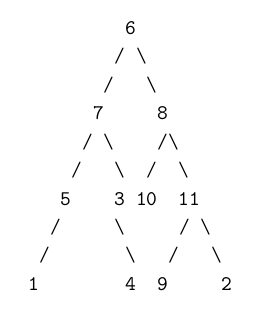
Reputation: 3636
Prolog and facts database
Im learning Prolog and I have some questions for you. I want to learn how to do these problems not the final solution.
As a newbie I have so little knowledge about this language but I dont want to be a cheater :(
OK so my question is...
I have define a binary tree like this:
tree(ID_of_tree,root,ID_left_tree,ID_right_tree)
For example, this tree
Is defined like this
tree(a4,6,b3,b4).
tree(b3,7,c1,c2).
tree(c1,5,d1,nil).
tree(d1,1,nil,nil).
tree(c2,3,nil,d2).
tree(d2,4,nil,nil).
tree(b4,8,c3,c4).
tree(c3,10,nil,nil).
tree(c4,11,d3,d4).
tree(d3,9,nil,nil).
tree(d4,2,nil,nil).
They are facts in my facts database. So my first question is, how to identify the father of a node N in this database. For example:
?-father(3,a4,P).
P=7
?-father(6,a4,P).
false
Defining predicate father/3.
father(N,Abn,P).
N= Node that I want to get its father
Abn = Tree where Im looking for. If a4, this means that is the all tree in this case.
P = Father of N.
I was thinking to use findall/3 but with this I have 2 problems. One this returns a list and I want to get a single number or false. And two, I dont know how to get to the base case if this must be done with recursion.
I think that I need to use some predicates like retract or asserta for example but Im not sure about this.
This is my first attempt but the output using father(3,a4,P). is false
father2(N,Abn,PA,PA):- =(N, PA).
father(N,Abn,P) :- tree(Abn,N,A1,_), tree(A1,PA,_,_), father2(N,A1,PA,P).
father(N,Abn,P) :- tree(Abn,N,_,A2), tree(A2,PA,_,_), father2(N,A2,PA,P).
My second attempt is this and it returns a good solution
father(N,Abn,P):- tree(FT,N,_,_), tree(_,P,FT,_).
father(N,Abn,P):- tree(FT,N,_,_), tree(_,P,_,FT).
This could be good but I have a problem with this predicate for example
father(3,d3,P).
P = 7
I should limit the search tree if Im looking in a subtree
Ok, finally I got it. This is my finally attempt and working like charm.
First of all I created a predicate named check_tree/2 . This predicate check if a tree is a subtree of other tree. For example:
?- check_tree(c4,c2).
false
?-check_tree(d1,b3).
true
This is the code for the check:
check_tree(Abn1,Abn1).
check_tree(Ab1,Ab2):- tree(Ft,_,Ab1,_), check_tree(Ft,Ab2).
check_tree(Ab1,Ab2):- tree(Ft,_,_,Ab1), check_tree(Ft,Ab2).
And next I define the predicate father/3 like this:
father(N,Abn,P):- tree(FT,N,_,_), tree(_,P,FT,_), check_tree(FT,Abn).
father(N,Abn,P):- tree(FT,N,_,_), tree(_,P,_,FT), check_tree(FT,Abn).
Now I only calculate the father if the node is inside of the search subtree.
?- father(3,b3,P).
P=7
?- father(3,c4,P).
false
Special thanks to luker and Will ness for the hints and their patience.
Thanks anyway for read this question.
Upvotes: 3
Views: 423
Answers (1)

Reputation: 71099
You don't need to search in a tree yourself - you already have it taken down to pieces (nodes) in your database. Prolog will search it for you.
You already have
father1(3, a4, P):- % first approximation
P = 7.
This is the first approximation to your predicate. Try it:
?- father1(3,a4,7).
true.
?- father(6,a4,P).
false.
Correct! But it is also the case that
father2(3, a4, P):- % second approximation
tree(c2,3,nil,d2),
( tree(b3,7,c1,c2) ; tree(b3,7,c2,c1) ),
P = 7.
and so, also
father3(3, a4, P):- % third approximation
tree(C2, 3, Nil, D2),
( tree(B3, P, C1, C2) ; tree(B3, P, C2, C1) ).
Do you see where I'm going with this?
Two remarks. First, why this representation, and not just as a term? Will your trees have shared branches in them? Cycles?
Second, a4 isn't used here. Why should you need it at all? Do you envisage duplicates in your tree and want to restrain your search to a sub-tree?
But if this isn't an oversight on your part, and you really do want to constrain your search, you can augment the above father/3 predicate to be used as a building block for this: continue searching for a father until you hit the one you're searching for (i.e. a4 in this case) -- or not (i.e. did not encounter it on your way up, meaning you're in the wrong part of the tree). You'll need to tweak it to find not only the value, but also the ID of the father (add a fourth argument to it).
edit: Here's how you could go about it:
father4(Three, A4, P, B3):- % fourth approximation
tree(C2, Three, Nil, D2),
( tree(B3, P, C1, C2) ; tree(B3, P, C2, C1) ).
Then, if you formed a transitive closure of the extended father4/4 predicate w.r.t. its fourth argument, it'd be as simple as
is_under1(3, a4):-
transitive_closure(father4(3, a4, _), List_Of_IDs), % pseudocode
memberchk(a4, List_Of_IDs).
and then if it's true, you know you're in the correct subtree. You can code the conjunction by hand, it's a good exercise to get yourself a real feel for the language as well as the theoretical foundations. Consider how an apprentice must do every menial task by hand first, when they start, and only then proceed to learning the complex tools that do the job quicker. Of course a day will come when everything will be done by 3D printers, but until then (or even then), we can indulge in treating our trade as an art.
But coding it by hand also gives you a chance to make it more efficient, stopping the search as soon as the parent ID is found (in case that it is found):
is_under2(3, a4):-
father4( 3, a4, P, B3),
( B3 == a4 , ! % a cut, if you would like it
; is_under( ... , ... ) ). % recursive call
Calling it by different name helps.
Notice the recursion: 3 is under a4 if a4 is 3's father (called B3 there), or if the 3's father is under a4. Makes total sense, right?
Upvotes: 3
